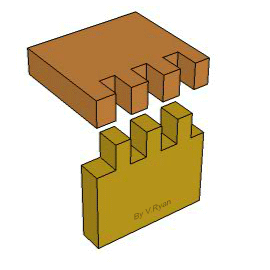
The situation is much more unfavorable if the rated flywheel energy of 5600 Nm is applied over a working distance of h = 3 mm. If the same force were to act over a distance of only 3 mm, the energy expended is 3000 Nm, and the force of the press then is fully used, while the available energy is not completely used. The press then is being used to the limits of its rated force and energy. If a metalformer uses a press with the parameters specified above to apply a constant force of 1000 kN over a distance h of 5.6 mm, the energy used during forming is W = F x h= 5600 Nm. before BDC a slide load of only FN0/2 = 500 kN is permissible. The force-vs.-crank angle curve indicates that the press in question may be subjected to a nominal load of 1000 kN between 30 deg. before BDC, the movable parts must be subjected to smaller stresses to avoid overloading. also have been designed for the torque corresponding to the nominal press force. before BDC to indicate that from here to BDC, the drive components that transmit the power-driveshaft, clutch, etc. In most cases, stress on the frame is kept low to achieve maximum possible rigidity. Nominal load represents the greatest permissible force in operating the press, defined on the basis of the permissible level of stress or by the deflection characteristics. The given nominal load FN0 in a mechanical press indicates that this value is based on the strength calculations of the frame and the moving elements located in the force flow-crankshaft, connecting rod and slide. The overall energy stored in the flywheel: before bottom dead center (BDC) usable energy/ press stroke during continuous operation WN = 5600 Nm continuous stroking rate n = 55/min.Īssuming a slowdown of 20 percent during continuous stroking, the usable energy is 36 percent of the total energy available in the flywheel. Deep drawing also is increasingly being performed in single-action presses (right) with drawing cushioĬonsider a press with rated force FN0 = 1000 kN = at 30 deg. Blank-holder and drawing slide are drivenįrom one main shaft, so the two function in a fixed


Knuckle-joint system retains the blankholder and a multi-link driveĮxecutes the drawing process. However, this gives no indication of the resulting forces and of the stress exerted on the press components.ĭouble-action presses (above) equipped with mechanical or hydraulicĭrives find use for deep drawing.


In continuous operation, a flywheel slowdown of 15 to 20 percent is estimated to be the greatest speed drop permissible. Since the energy in the rotating flywheel is only partially used during a press stroke, the electric motor driving the flywheel is not overloaded and does not need to have a large power capacity. These principles apply to mechanical presses, but rather than a raised weight moving over a distance to perform work, energy is stored in the rotating mass of the press flywheel. When work is performed, the distance over which it is performed determines the magnitude of the generated force. This corresponds in the force-distance graph to the area of the rectangle below the force curve. When force is applied over a certain distance, work is performed. Fundamentals of Mechanical-Press Design June 1, 2009įorce and work are two terms that can be related only by means of a third variable, distance.


 0 kommentar(er)
0 kommentar(er)
